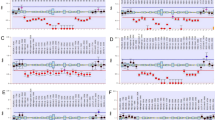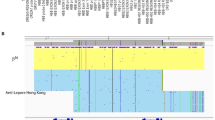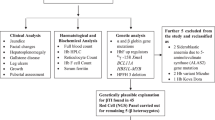Abstract
FOUR clinical syndromes are associated with α thalassaemia: (1) the silent carrier state (α thalassaemia-2) with no clinical effect; (2) heterozygous α thalassaemia (α thalassaemia-1) in which a more severe defect in α-chain synthesis produces microcytic red cells but little or no anaemia; (3) haemoglobin-H disease usually the combination of α thalassaemia-1 and α thalassaemia-2 resulting in mild to moderate haemolytic anaemia and (4) hydrops fetalis associated with haemoglobin Barts an invariably fatal condition which represents the homozygous state of α thalassaemia-1 (for recent reviews see refs 1 and 2). To explain these syndromes one hypothesis proposes that α thalassaemia-1 and α thalassaemia-2 are caused by a defect of greater and lesser severity affecting alleles of a single α-globin locus3. A second hypothesis is based on evidence that the α-globin structural gene is duplicated4; the four syndromes may be the result of involvement of one, two, three or all four α structural genes by thalassaemia. In this study we tested these hypotheses by measuring the number of α-globin structural genes in haemoglobin-H disease and the results firmly support the latter hypothesis.
This is a preview of subscription content, access via your institution
Access options
Subscribe to this journal
Receive 51 print issues and online access
$199.00 per year
only $3.90 per issue
Buy this article
- Purchase on Springer Link
- Instant access to full article PDF
Prices may be subject to local taxes which are calculated during checkout
Similar content being viewed by others
References
Stamatoyannopoulos, G., and Nute, P. E., Clinics in Haematol., 3, 251–287 (1974).
Wasi, P., Na-Nakorn, S., Pootrakul, S., Clinics in Haematol., 3, 383–410 (1974).
Na-Nakorn, S., and Wasi, P., Am. J. hum. Genet., 22, 645–651 (1970).
Lehmann, H., Lancet, ii, 78–80 (1970).
Ottolenghi, S., et al., Nature, 251, 389–391 (1974).
Taylor, J. M., et al., Nature, 251, 392–393 (1974).
Gianni, A. M., Giglioni, B., Ottolenghi, S., Comi, P., and Guidotti, G., Nature new Biol., 240, 183–185 (1972).
Mathews, M. B., and Korner, A., Eur. J. Biochem., 17, 339–343 (1970).
Lehmann, H., Lancet, ii, 635–637 (1970).
Hollan, S. R., et al., Nature, 235, 47–50 (1972).
Abramson, R. K., Rucknagel, D. L., and Shreffler, D. C., Science, 169, 194–196 (1970).
Beaven, G. H., Hornabrook, R. W., Tax, R. H., and Huehns, E. R., Nature, 235, 46–47 (1972).
Lie-Injo, L. E., Pillay, R. P., Thuraisingham, V., Blood, 28, 830–839 (1966).
Author information
Authors and Affiliations
Rights and permissions
About this article
Cite this article
KAN, Y., DOZY, A., VARMUS, H. et al. Deletion of α-globin genes in haemoglobin-H disease demonstrates multiple α-globin structural loci. Nature 255, 255–256 (1975). https://doi.org/10.1038/255255a0
Received:
Revised:
Issue Date:
DOI: https://doi.org/10.1038/255255a0
This article is cited by
-
Genomic views of distant-acting enhancers
Nature (2009)
-
Hereditary pancreatitis caused by a double gain-of-function trypsinogen mutation
Human Genetics (2008)
-
Copy number variants and genetic traits: closer to the resolution of phenotypic to genotypic variability
Nature Reviews Genetics (2007)
-
A leftward deletional ?+ thalassemia found in East Sicily in conjunction with heterozygous ?-thalassemia
Human Genetics (1984)
-
Duplication of the hemoglobin α-chain gene in sheep: Characterization of a new α-chain variant present in animals possessing the αLeu and theIIαHis chains
Biochemical Genetics (1983)
Comments
By submitting a comment you agree to abide by our Terms and Community Guidelines. If you find something abusive or that does not comply with our terms or guidelines please flag it as inappropriate.



